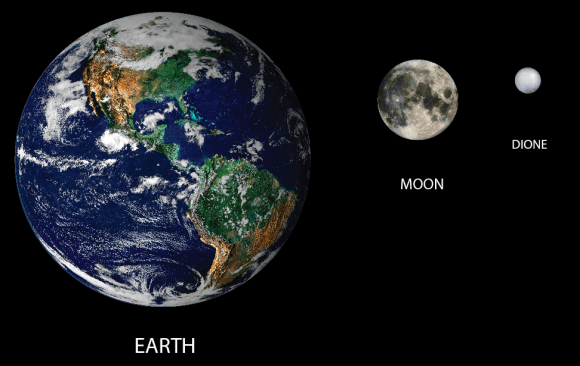Color-composite of Dione made from raw Cassini images acquired on Dec. 23, 2012. (NASA/JPL/SSI. Composite by J. Major.)
Although made mostly of ice and rock, Saturn’s moon Dione (pronounced dee-oh-nee) does have some color to it, as seen in this color-composite made from raw images acquired by Cassini on December 23.
700 miles (1120 km) wide, Dione is covered pole-to-pole in craters and crisscrossed by long, bright regions of “wispy line” terrain — the reflective faces of sheer ice cliffs and scarps that are too steep for darker material drifting in from Saturn’s E ring to remain upon.
The composite was assembled from raw images captured in red, green and blue visible light wavelengths by Cassini from a distance of 154,869 miles (249,238 km).
The view above looks at a region on Dione’s mid-northern hemisphere. The bright-walled crater in the center surrounded by warmer-hued terrain is named Creusa, and the long rift system next to it is Tibur Chasmata, which runs north-to-south. Dione’s north pole is to the upper left.
Dione’s heavily cratered areas are most common on its trailing hemisphere. Logically, a moon’s leading hemisphere should be the more heavily cratered, so it has been hypothesized that a relatively recent impact spun Dione around 180 degrees. The moon’s small size mean that even a modest-scale impact could have done the job.
Relative sizes of Earth, Moon and Dione (J. Major)
Dione orbits Saturn at a distance of 209,651 miles (377,400 km), closer than our Moon is to us.
See more images and news from the Cassini mission here. And for more on Dione, see some of my previous posts on Lights in the Dark.



Your relative size image above really helps me visualize the Saturnian system… I’d like to see the same thing done with Saturn itself in the picture with _all_ of it’s moon’s, compared to Earth and Luna.
On my monitor Dione is slightly more than 1/4 inch wide which would make Saturn about 27 inches wide with the rings extending out another 27 inches!!!!
That Cassini spacecraft is worth its weight in gold, we get such fantastic views of the future tourist hot spot of the solar system.
The relative size graphic is very nice, and, and in line of comment, ever helpful in grasping comparative dimensions.
Dione of course could be another of these subsurface ocean bodies, similar to Europa or Enceladus. This means Dione is a candidate for biology. Maybe there are small geysers there that a flyby probe could pass through.
LC
All this time I’ve been saying DI-oh-nee.